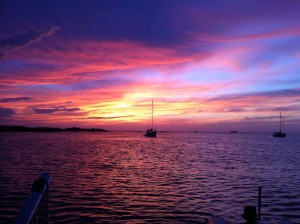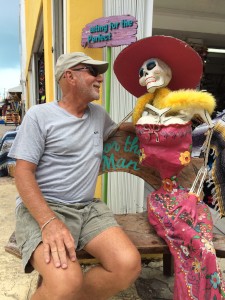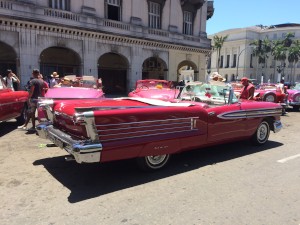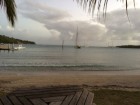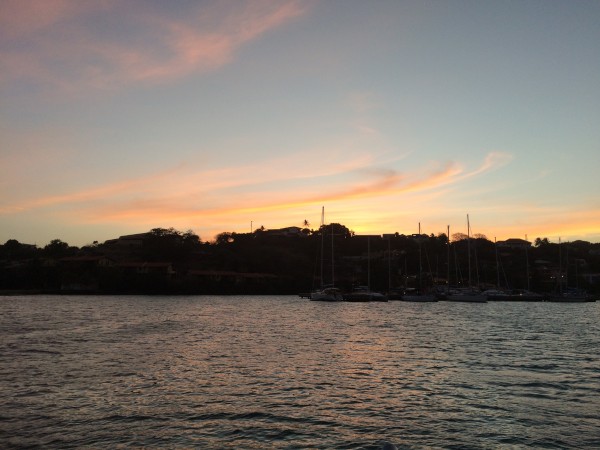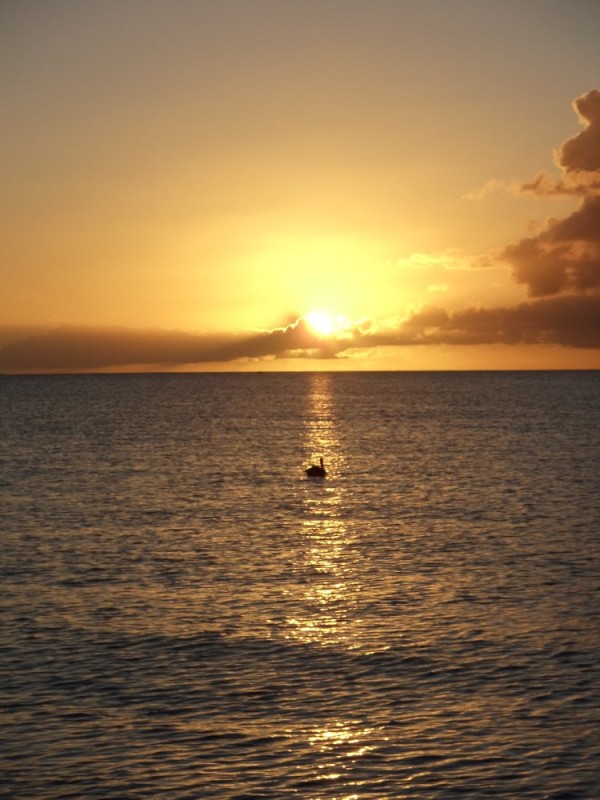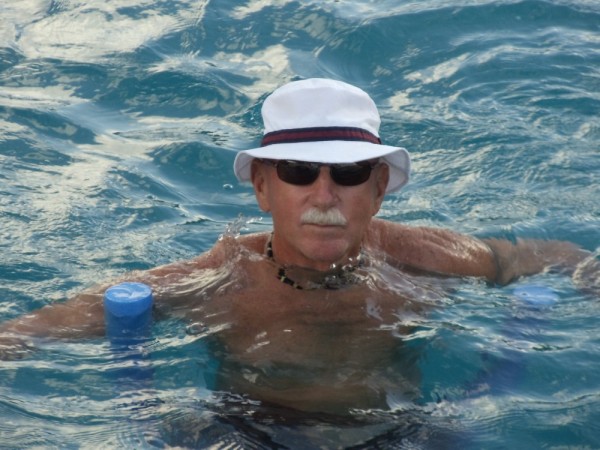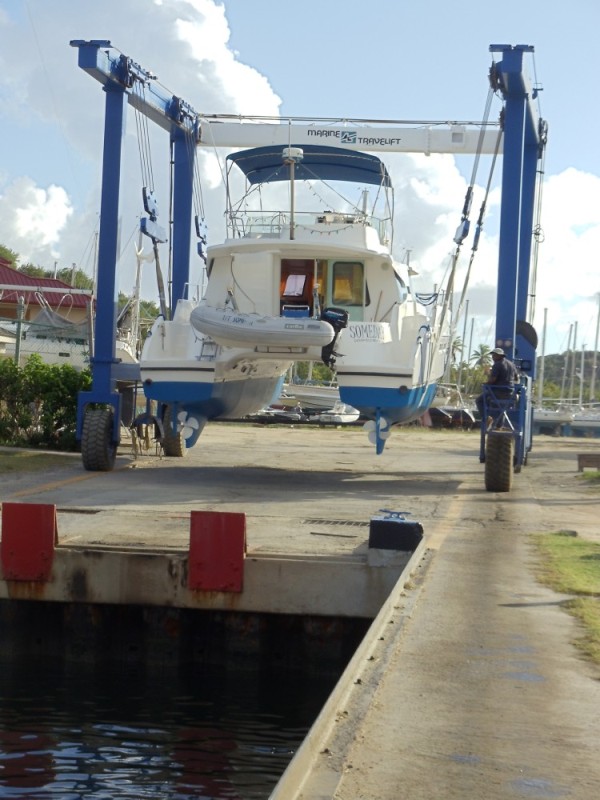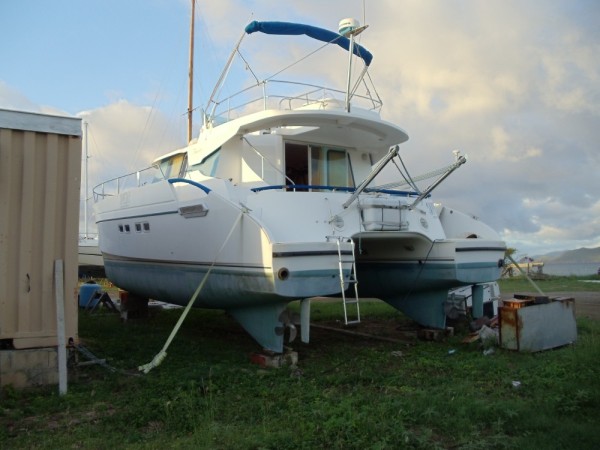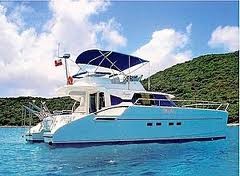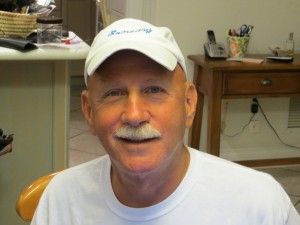Return to Someday
| Vessel Name: | Someday |
| Vessel Make/Model: | Fountaine Pajot Maryland 37 |
| Hailing Port: | Deerfield Beach |
| Crew: | Joe G |
04 June 2016
MEXICO ON LESS THAN $50 A DAY
One thing is certain, cruising the Mexican Caribbean coast is notably less costly than the rest of the Caribbean. We can buy food in grocery stores and markets very inexpensively, and dining out is not only cheaper, but the food is far more reliable than dining elsewhere in the Caribbean. We can have [...]
13 May 2016
Mexico Dreaming
Stayed at Cabo San Antonio, Los Morros, at the western tip of Cuba to check out of the country, obtain our all important "Despacho", and cross to Mexico. The 'marina', I use that term loosely, is an unsheltered, rough hewn, concrete pier, lacking any resemblance to a marine facility. It's not surprising, [...]
20 January 2013 | St Thomas
This is not the real world, this is St Thomas
Boury's visit continued to North Sound at Virgin Gorda, to the Bitter End, Saba Rock Resturant, and YCCS, Yacht Club Costa Smeralda, (see pasta wrapped salmon and "The chef"), where we ran into The Falcon again at the dock. She is a marvel of technology and looks and the longest private sailboat in [...]
MEXICO ON LESS THAN $50 A DAY
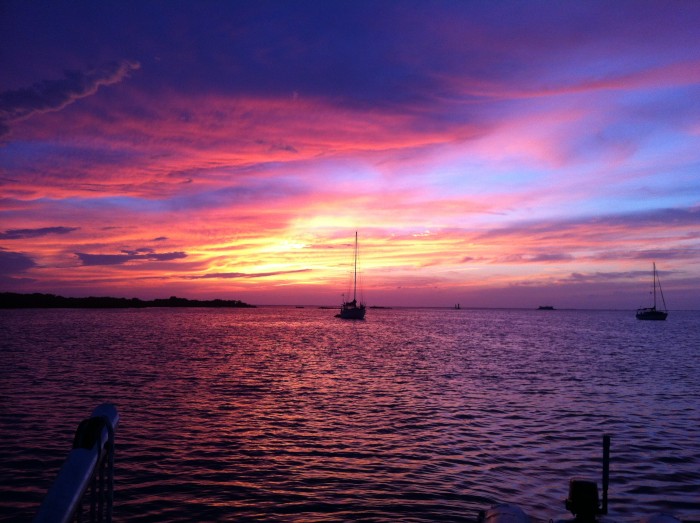
We haven't paid for a dock since our first week in Isla Mujeres and we fill the tanks with water (non-potable, of course) every ten days for less than $15. (We loaded the bilges with gallon jugs of purified water before we left home.)
We gassed up -on fuel ,not refried beans - as we left Isla Mujeres. I was surprised by the price of diesel ($3.75 a gallon vs. under $2 in Key West) since Mexico is an oil-rich country, but then remembered that the Mexican government gets over half of its revenues from Pemex (the government-owned and the only gas company in Mexico) so it sort of makes sense that they would raise the per gallon retail cost when they are getting such a lousy price per barrel in the market. They have to keep the government running. That's my theory at least.
South of Isla Mujeres, we are finding that not many boats cruise the Mexican coast. We were one of only two boats anchored off of Puerto Morales, despite it being a cute Mexican beach town with friendly people, good shops and restaurants and one of the prettiest, healthiest reefs I've seen in years.
At Cozumel we were one of a handful of boats anchored off and, when we went into the big marina south of town for water, we did not see cruising yachts there. The marina was full of local boats that service their tourism industry. Further south, we only saw one other cruiser and they simply anchored near us and were gone the next morning when we awakened.
We found Cozumel frustrating. Beautiful, spectacularly beautiful, clear water, but much of the coastal area is a marine sanctuary and we learned (from a visit by the park guards less than three minutes after we dropped an anchor in a sandy spot, not even near a reef) that you are not allowed to anchor anywhere in the reserve. Technically, we learned later, you aren't even supposed to take a private boat into the sanctuary areas. Mexicans can get a license to take groups snorkeling or diving in the park, but even they are not allowed to anchor there. And no one can fish there.
The day boats bring large groups of people to snorkel, make them wear life jackets (a park requirement, apparently), and keep them in a small herd in areas that looked like rocks rather than reefs. That was not appealing to us, so we never got to snorkel. The beautiful reefs are deep and require scuba gear and are also located in the marine preserve. The dive boats have to drift as there are no mooring balls and are not allowed to drop an anchor.
Cozumel is completely geared to the 2-3 cruise ships that arrive daily and the hoards of people who come across for the day on the ferry from Playa del Carmen. Fifty or more shops all selling the same junky stuff and the restaurants were charging U.S. prices. You had to get a good distance away from the waterfront before prices (and the atmosphere) became more Mexican. Seven blocks away we found a little outdoor lunch counter selling delicious shrimp or fish tacos for a dollar and, around the corner, a shop selling good pottery and furniture from Central Mexico.
The owner of the latter shop told us prices were so high downtown because the rents were so high there. Joe went on a small shopping spree there and was bargaining hard with her, getting her to drop prices 30% and give him a better exchange rate than her posted sign. When he came up two U.S. dollars short, he told her he'd give her a kiss instead. She looked at me like he was crazy and I said to her in Spanish, "He is a great kisser. Se vale la pena (It's worth it.)." She was having none of it, but he kept trying. She turned to me and said (in Spanish) "He's quite the flirt. Doesn't it make you jealous?" I responded, "No. It's not serious." She asked, "You mean he's joking?" I said "yes and no", at which point he starts wiggling his hips and dancing, waving his hands in the air, unaware of what we are saying, unless he knows a lot more Spanish than he lets on. She looked at me with wide eyes and said "He must take a lot of Viagra." She & I had a good laugh. At that point I told him I had the two dollars in pesos, but he took two U.S. dollars from his wallet, gave it to her, and then asked in English "Where is my kiss?" She finally let him kiss her on the cheek only, then rushed around the counter and gave me a peck on the cheek, saying it "Was out of respect" to me.
Later at lunch we were talking about Mexican cultural habits (like men giving you directions, even though they have no idea where the place is you are seeking), and I mentioned that the woman at the store really did not want to kiss him and he pushed that a bit far. He could not believe it; inconceivable to him, apparently, that someone wouldn't want to kiss him!
Just south of Cozumel, there is one marina, then that's it to the border of Belize. We now know why so many of the boaters we met in Isla Mujeres never stopped along the Mexican coast as they made their way north. A number of the small bays or inlets are either privately-owned or marine preserves where you can't anchor. There's really nowhere to anchor until you get to two remote bays, the first of which is 30 miles south of Tulum.
The first bay, Ascencion Bay, was developed as a flats fishing mecca in large part by a friend who used to guide in Key West. I had been there back in the early 90s when he was the only fishing guide in Punta Allen and was helping to put the place on the map. Punta Allen back then was a little fishing town at then end of a tortuous 30 mile sand. (Still unpaved, we were told, and still a very rough ride.) There are many more houses now and four fishing camps/hotels and several restaurants, and the locals seem to have a good business running tourist down from Tulum through the lagoons to see birds, porpoises, turtles, etc then have a buffet lunch at restaurants on the beach. (At least 20 boats a day full of tourists whizzed past our boat twice a day.) I thought it was a little paradise twenty years ago, off the grid definitely, but a beautiful spot with spectacular fishing. Now, despite the obvious employment eco-tourism has brought, the houses people live in were sad and it was stifling hot in town. We stayed anchored off there for two days, with no luck at all with fishing despite finding beautiful flats on the right tide.
So we moved to the Culebra Keys in the middle of the Bay, where I had another day of frustrating fishing (meaning no fish), although we saw guide boats land a big tarpon and a bonefish on a flat near where we anchored. Before dusk that evening, I took the dinghy out and found a group of fishermen pulling in a net with bonefish in it. I presume that is illegal because the entire bay is a marine preserve.
That night we saw little crabs in the water behind the boat and were able to net a bunch of them. The next day, armed with live crabs, I finally found bonefish on a flat and hooked two and caught one. It took a while to figure out how to fish them, but hope I've gotten the hang of it now. (Caught another the next day.)
Joe came down with a very bad cold in Punta Allen and has been laid low many days. He's a trooper and carries on. Even as I write this 11 days later, he is still sniffling and has moments of weakness and dizziness. No fun to have a cold in the hot tropics.
As we left the bays heading south, the water was crystal clear and we saw at least 100 large turtles in a two hour span. It some places, we would spook 5-6 turtles whose shells had to be 3 or 4 feet in diameter. We had seen plenty of big turtles in Ascencion Bay, but to see so many in a short time span was remarkable. It is the period when the turtles lay their eggs on the beaches and they were very skittish. In the Florida Keys you often see turtles lolling around on the water surface and they only dive if you get close to them. These turtles stayed underwater most of the time and, when surfacing for air, just stuck their head out to get air and dove right back down. We were impressed with how quickly they could scoot away.
After being out of touch with the outside world for about a week, we came to a pleasant beach town called Majahual, where a cruise ship comes in about twice a week. As has been the case numerous times, the cruising guide (the only one for this area) is way out of date and suggests anchorages that are sometimes a bit precarious. We had to ask a local dive boat to guide us through the very small cut through the reef at Majahual and show us where to anchor. The water was extremely shallow everywhere inside the reef and we were in one of the few spots you could anchor.
It was a pleasure to go ashore and eat at restaurants. We found a good bakery and some fresh produce and enjoyed the scene. We arrived on a weekend and the town was full of Mexican families. The restaurants are right on the beach and have umbrellas and chaise lounges for their customers to use, so people come to the restaurants with coolers full of soft drinks, take over a table and chaises for the day and order food non-stop. The kids stay in the water virtually all day, coming out only to take a few bites of food and drink soda after soda.
We were a little shocked at how high the prices at the restaurants were (not quite U.S. prices, but close). The menus were all priced in U.S. dollars. I told the waiter the prices were too expensive and asked if he had a peso menu. He brought back the same exact menu, priced in pesos and considerably cheaper. From then on, we told the waiter we were locals not cruisers so bring us the peso menu.
We came to Majahual because it is the last place you can check out of Mexico on a boat. We had read that there was no immigration office in Majahual, but Immigration comes out on the days that cruise ships check in. So we had checked the cruise ship schedule and timed our arrival for the day before a cruise ship arrived. But the Port Captain, who came out to our boat and told us we had to check in with him, said we had the schedule wrong and a cruise ship wouldn't arrive for four more days. We liked the town, so said we'd wait. He told us there was a local agent who handled the paperwork for the cruise ships and, for a fee, he didn't know how much, we could use the agent to handle all our paperwork.
On Monday morning I saw a cruise ship offshore and went to the Port captain's office and were told both that the Immigration person already left and that they never came, and that an agent handled the paperwork for the cruise ship. (It's Mexico.) The agent waiting for us was a young man, with a raft of paperwork and starts rattling off what we need to pay. It was crazy expensive. Adding up what he was saying in my head I came up to almost $600 U.S. I said that was ridiculous. We had already paid several hundred dollars to bring the boat into Mexico, why did we have to pay so much to leave? He pulls out a copy of the Mexican immigration laws and is pointing to figures in there. I was scanning it in Spanish as he spoke but he was going so quickly I was getting lost, but I knew we were being ripped off. After 45 minutes of complaining and expressing disbelief, I asked him if he would lower his fee, at which point he drops his fee in half and eliminates a $200 fee he was quoting us for Immigration. We finally agreed to pay $255 for the privilege of leaving Mexico. Mexico is a wonderful place and petty larceny is the price you sometimes must pay to enjoy it. It was an aggravating way to end a delightful month in Mexico , but you have to let it go.
We left the Port Captain's office with just enough pesos left to buy some eggs and juice, then have some fresh fish and multiple margaritas. We watched American college girls from the cruise ship get totally drunk and Midwesterners get sunburned, happy in the knowledge they were paying for their margaritas with dollars and we weren't.
Eso es Mexico.
On to Belize.
Mexico Dreaming
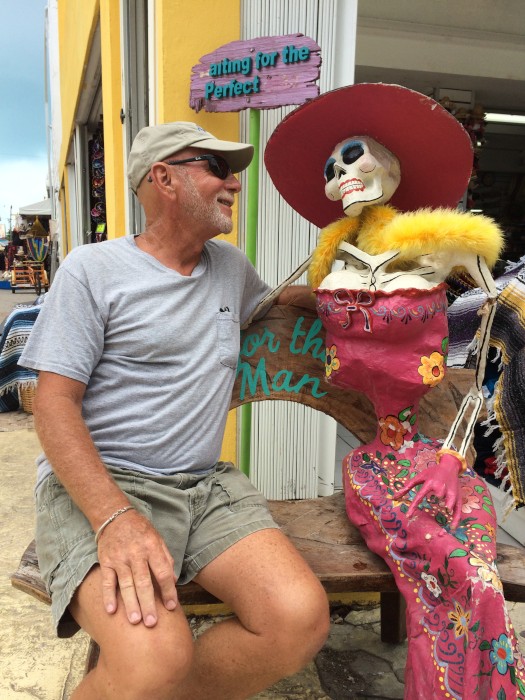
We met a cute younger couple, ( ok, a lot younger than us ), He German, she Russian, "I'm from SEBERIA" she kept saying in a charming Russian accent, "What do you expect?", heading for the States. Had them over for a drink (well neither of them drink), and fresh caught tuna sashimi.
Cabo San Antonio does however, have a permanently manned Guarda Frontera station, to insure you are not smuggling a Cuban out. ( There is still a surprising cold war mentality prevailing when it comes to boats. ) All the time we were in Cuba, even in a government owned marina, ( they are all gov. owned ), you are not allowed to have a Cuban national aboard, even for a drink. You must apply for permission 24 hrs in advance. And that permission may be denied.
The Yucatan Channel, separating Cuba and Mexico, is 110 miles wide, and 5 thousand feet deep. All the ocean currents traveling west through the Caribbean, and there are lots, turn north when they hit the Mexican coast. They get squeezed in the Yucatan channel and accelerate to 4 or 5 knots! That's a fast current. This is the current that turns east thru the straights of Florida, then north along FL east coast and we call the Gulf Stream. There it travels north at only 3 knots.
To cross it requires favorable winds, and correcting for the north set of the current. We left Cuba at 6 PM and arrived at Isla Mujeres, Mex. 8 AM the next morning. No problems. Mujeres, The Island of Women, not sure how it got it's name, just off the coast from Cancun, is a great, tourist town with a good anchorage, several marinas, good facilities, and about a hundred funky bars and restaurants. kinda like Key West 25 yrs ago.
Met back up with a Canadian boat, Ocean Ranger, we befriended in Hemingway marina.
Stayed at Marina El Milagro, very good ( read cheap ), very friendly and very cute with a family style BBQ weekly. Then SEBERIA shows up! They met some strong counter winds, had engine probs, and turned around for Mexico.
Rented a car and drove to Chichen Itza, one of the best-restored Mayan sites with a huge pyramid. Stayed at a beautiful resort, walking distance to the archeological site. Drove thru many small towns, got a real feel for back country Mex. Thank God Connie is fluent and my guide and interperter. BTW, all thru our trip so far, we have enjoyed the most supreme weather, cool, sunny, delightful.
We used the car to go to Costco in Cancun to stock up, including a case of sparkling wine, a necessity when cruising with Connie.
May 6, we went north and west around the peninsula to Isla Holbox (pronounced hol bosh, its a Mayan name ). Now this out of the way, sand street beach town is like Key West 50 yrs ago, but has acquired a cool, tony, patina, and many jetset A listers include it as a de rigeur hip travel stop. Lots of VERY funky bars and eats, and MEX food stands at night around the town square. Carnitas, tacos, hamburguesas, and the famous Lobster Pizza restaurant. Fish and octopus ceviche has been incredible all thru the trip. The Whale Sharks, Manta Rays and flamingos migrate here pretty soon now.
After a week in Hotbox and another area, we returned to isla Mujeres for fuel, (first time since KW), fresh veggies and water, and will head to Cozumel and points south.
So my land bound friends, keep keeping on. Im taking lots of pics, just having trouble trying to get them uploaded with sporadic internet service at the marinas.
Notes from Connie: I was so happy to get to Mexico, a place that is embedded in my heart. Joe asked me why I love Mexico so. How can you not? The friendliness and politeness of the people, the colors, the beauty of the land whether its high desert or the Caribbean waters and sand, the lively and colorful markets, the bartering, the men who sing terribly but still give it their all, the dichotomy between the apparent simplicity of life here and the underlying complexity of the culture, and, of course, the food. I never can convince friends that Mexican food is not what they get in the U.S.
It has been interesting to see three places I haven't been for many years. Isla Mujeres I had visited with my niece, Emily, almost 25 years ago. Its has grown 8-10 times larger than the tiny 4-5 block town it was then, but I actually like it better now. Its a very touristy place but thoroughly enjoyable and has a steady cruiser population. We stayed for a week then went to Isla Holbox, a day's cruise to the northwest.
I had visited Holbox once over ten years ago and was delighted by it then. It was obvious it would be developed because it is such a lovely island. Development has occurred and has actually improved it, except that I couldn't catch a fish (only one keeper grouper), whereas the last time I was there the fishing was terrific. The "marina" that had 4-5 fishing boats 10 years ago had 30-40 now, and they fish with nets which destroys fish populations. But the food was great, the scenery beautiful, and the little town had nice shops with good crafts from all over Mexico, and even a movie theater that operated on the weekends.
Unfortunately, we were too early for the flamingos and the whale sharks, for which the island is famous. They should arrive any day, we were told, as they generally are there from mid-May to mid-August.
And finally, Chichen Itza, which I have visited 4-5 times over a 35 year period, the last time with my nephew Will and his Mom perhaps 13 years ago. It has somehow lost its wonder for me. I always thought it was such a magnificent place, so mysterious and endlessly interesting. Perhaps its because they no longer let you climb the pyramids and other buildings. I completely understand why. It was always dangerous, with the steep, slippery steps, and clearly not good for the preservation of the structures. But not being able to do that and see the carvings up close diminished the visit. Plus the carvings are degrading and there is so little of the original paint left on the stucco compared to my early visits. That gave you an idea of how dramatic the buildings must have seemed, painted in bold primary colors.
The other issue at Chichen Itza is that they now let vendors set up all over the site, rather than just at the entrance. At first it was irritating, but then became amusing as we were asked to buy thing "almost free" and "Cheaper than Kmart".
As I write this, we just finished a drift snorkel in Isla Mujeres, home made margaritas and guacamole.
We've been cruising now for over a month and I haven't been bored yet. Guess I was finally ready to calm down.
P.S. Joe drinks just as much sparkling wine as I do!
Cuba Si si
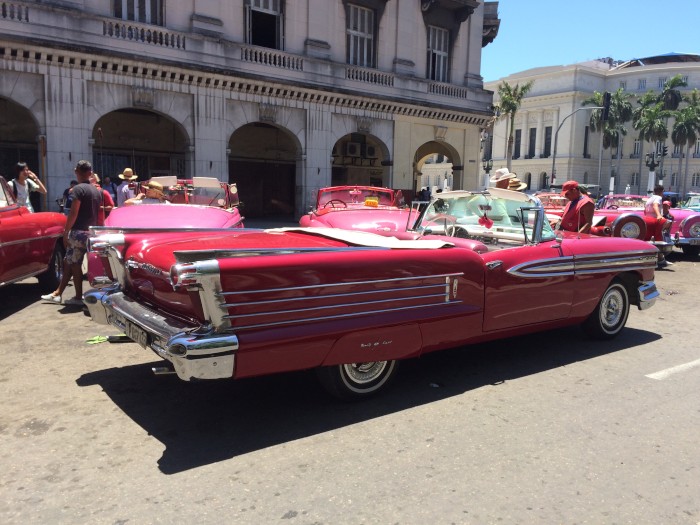
After a mad dash, we finally left Deerfield on Sunday afternoon, April 12th , at 3 pm with me (Connie) sick and trying to file my tax return and set my bills up for online payment in the moments before we left. Joe found it is harder work to leave on a four month trip with Someday docked behind his house, than flying into a distant port with just his electronics and clothes. Someday was weighted down with all of the supplies we were taking for a four month cruise. At the end we were just throwing things into the cabin so we could leave. In the rush, Joe forgot a few things, including all of his bathing suits, his sweatshirt & hoodie, his tennis shoes and, OMG, his Kahlua!
As he motored down the Intracoastal, I was in the cabin trying to bring order to the mess. We made it only as far as the lagoon at Baker's Haulover by sunset, ate dinner aboard and fell into an exhausted sleep. A dinghy ride into Miami Beach the following morning produced a bottle of Kahlua for Joe and cold medicine for me. You see where the priorities lie.
We ran the next few days through the Keys, stopping only to anchor for the night and once to snorkel on Looe Key which, amazingly, Joe had never snorkeled before. It was a bit rough that day and fish not as plentiful on the reef as they are in the summer, but he did get to see the two resident Goliath groupers, curious creatures that came right under the boat to check him out.
That evening we anchored off a totally deserted cut in the Saddlebunch Keys. I tried out my new rod & reel (thanks, LBTS management team; it's a terrific outfit), but nothing was hitting. We roasted a chicken and had a good dinner, some champagne to celebrate finally getting away, and a very peaceful night's sleep. We were awakened early by Navy fighter jets roaring overhead on their morning runs and, when we looked out the portholes from our bunk, we saw we were surrounded by flats boats fishing for tarpon. We did not hear or see a tarpon roll the night before, but a guy hooked a big one just 50 feet from the boat and we watched it jump a few times and pull his skiff out to sea. Thirty minutes later he was back, still fighting the same fish. He was still fighting it when we pulled anchor. Hope he finally landed it.
On to Key West to buy new batteries as one of the two sets was not holding a charge sufficiently and we knew we would have difficulty finding them where we were going.(That's an understatement.) Fortunately, an electrical shop right next to the Key West Bight City Marina had two of the specific marine batteries we needed. (Having called shops from Marathon south to Key West, we were lucky to get the only two there were in the southern Keys.) After two disappointing meals out in Key West we concluded, as we always do, that the best food is aboard Someday.
The next afternoon we moved out to a temporary anchorage to stage for our crossing to Cuba that night. I was fishing while Joe napped, but we were in a shallow area and I was catching only tiny snapper. Joe awoke and said prepare to get underway. I figured I had time to cast one last shrimp out as the moon started to rise, and Bam! I got an enormous hit. It ran out line and fought like a big jack, so I was surprised when I landed a big beautiful mutton snapper, 7-8 pounds. Too beautiful to keep. We had no room in the fridge or freezer to store it, but I still don't think I would have killed that fish even if we were not Cuba-bound. Let it give another fisherman a thrill.
So, off to Cuba, on a beautiful, calm night. The crossing was uneventful, but chilly and rolly once we got about halfway there. We saw few boats until the Cuban Navy gave us a careful look around dawn. We entered Cuba at the Hemingway Marina, west of Havana at 8:30 a.m. on April 16th. It took us two hours to get through customs. First a doctor came aboard to take our temperatures, ask us questions, and fill out a long form. We passed. "What if one of us had a slight fever?", I asked him, knowing I had had a fever only days ago. "You would be taken to a hospital for a blood test", he replied.
The paperwork to enter Cuba on a boat goes on and on. The customs officers are very polite, asking permission to come aboard, to sit down, and they all take their shoes off before boarding. I could barely, however, understand a word that the guy who was assigned to us said. He spoke a mangled Spanish very rapidly and sounded like he was chewing glass. I had to ask him to repeat most things three times. Then the guy with the dog came aboard. Then a second dog. Then the original guy came back with more paperwork and looked through the boat. We were concerned they might confiscate, or we'd have to pay duty on, the four cases of wine we had stored in the bilges, but with all the forms and questions, they never asked if we had alcohol aboard. They were concerned about fresh eggs and chicken, neither of which we had because we had read not to bring them. Multiple forms had to be filled out with the same info on them. They then apologized that their computer was broken, so all the info on the forms had to be called in to a central office. Finally, after two hours, we were allowed to move to a slip.
Hemingway Marina is government-owned and collects all the fees for importing your boat and individual immigration fees which, by the way tripled in the last few months. We had no Cuban pesos with us but they were not bothered by that. Just pay everything when you leave.
The marina layout is odd. Four long canals with concrete, horizontal docks. Fortunately, we were assigned to the canal closest to the ocean, with good breezes and no smell of sewage as some of the other canals had. And, thankfully, the farthest location from the hotel that blares music into the night. Dockage is cheap, although some boaters complained it had doubled in cost in the past year. There is no marina feeling to the place and it's a long walk to anywhere.
It gets costly going into Havana, a 25-30 minute trip. Taxis wanted anywhere from $20-25 cuban dollars for a one way fare, although the cruising guide we were using that was written 2 years ago said the fare was $6. We did get a $15 fare once, but the driver's buddy had to push the car to start it and he had to stop at a gas station and put enough gas in the car to make the trip.
About money. The Cuban government discounts U.S dollars by 10%, as a penalty for our economic embargo of Cuba I presume. No other currencies are treated that way. And they charge a 3% commission on the exchange. So a $20 taxi fare is the equivalent of about $23.) We finally figured out the bus schedule on our last day at the marina, which would have saved us considerably, but involved a change of busses and took more time.
Havana we loved. It is a riot of color, music, public art, gorgeous decaying buildings, human statues and dance. And the best people-watching in the hemisphere. Characters everywhere. And costumes. People dress very originally there.
It's a sensory overload kind of place. Color bursts from the art work for sale in numerous cubby hole stores and in the sheen of the ubiquitous classic American cars from the forties and fifties painted in wild tropical colors that serve as taxis. The cars are maintained by Latin pure ingenuity. Joe's eye for cars identified every mismatched feature, but he was mesmerized by them. They lend a gaiety to the scene and seem to be an essential fabric of city life. And the source of a great deal of income to the people who own them.
Public artwork is everywhere, mostly sculptures, but some mosaic work and, of course, the omnipresent paintings of Che Guevera on building walls. Very good bands roam the sidewalk cafes and many bars have live music in the middle of the day. People dance the sensuous salsa and rumbas on the sidewalk, in the bars, and on the outdoor patios of cafes. We kept meaning to go into town at night to listen to music but once we were back at the marina, we were too lazy to do it. We talked about going in and staying overnight, which we should have done, but just didn't. That's life on a boat.
The food was very good in Havana and ran the gamut on prices. We had an incredibly fresh snapper ceviche for $2.50 at one place and a shrimp ceviche for $8 at another place. Lobster is $10 at some places, $35 at others. Lots of seafood and wonderful rum drinks. They cook meats on rotisseries and have some very artistic-looking rotisseries.
The museums did not live up to the guidebooks' exuberant descriptions, but the buildings they are located in were fabulous examples of a wide variety of architecture. We were disappointed we couldn't get to the French Impressionist wing of an art museum in a spectacular building because that floor was closed. But then we observed as we admired the beautiful stained glass ceiling from a lower floor that an entire corner of the building had broken off and was open to the cerulean sky.
In Havana, the people are constantly asking you for money and we were quite to susceptible to their pleas. Outside of Havana, we didn't experience much of that, although the people seemed much poorer.
Another boater told us to make sure we walked to the heart of the little fishing village, Jaimanitas, near the Hemingway Marina to see the mosaics. It was one of the highlights of our trip. A very poor fishing village ablaze in wild mosaic tile images of hearts, roosters, fish, men with 2 pockets on their shirts, sensuous women, suns and Picasso-ish paintings on tile that adorned their walls and houses. All designed by artist Jose Fuster, who moved to the village 23 years ago after experiencing success in the art world as a painter. He had a vision of transforming the little community into a living piece of art and he accomplished it. Although he is known as the Picasso of the Caribbean, the effect is much more akin to Gaudi's work in Barcelona. He started on his own house which is a fantastic expression of imagination and vibrant color, then ventured to ask some of his neighbors if they would like him to do the walls in front of their houses, seeking their guidance on the content they wanted. He has paid for the work entirely from the proceeds of the sale of his own artwork and has brought a small measure of prosperity to this poor town. His home is open to the public at no charge, which is a true gift.
We took a day trip by bus to the Vinales valley, one of Cuba's richest agricultural districts and one with a very unique geological distinction. It was an educational trip, with a guide who spoke about the Cuban economy, history and the reality of life for the Cuban people. We learned that tourism is Cuba's number one industry, followed by the production and sale of tobacco and rum. Cuba cannot grow enough food to feed the population, she said, not because of a lack of fertile land but because Castro's vision of producing a nation of professionals (engineers, doctors, etc.) has resulted in a dearth of farmers. But it appeared to us the true inhibiting factor was the total lack of modern farming technology. They were plowing their fields with a plow drawn by oxen. We did not see a single tractor.
You hear quite frequently from the Cuban people that the wage for most jobs is $30 a month; yes, a month, not a day or a week. They do receive what are essentially food stamps but they can only be used to buy true staples - flour, rice, beans. It seems quite impossible that a family could survive on that wage, even if everyone in the family worked. People working in the tourist trade certainly earn much more in tips and taxi drivers have to do well. They have to pay for a license from the government and are supposed to declare their income annually to the government. The income sets the price of the license, so they of course lie. We never saw a meter in a cab and the odometers in the old cars don't work, so there is no way to prove how often they drove. And now that things have been liberalized and you can open your own restaurant or guest house, that's a good source of income. But I can't help but believe that money delivered by their relatives who live in the U.S. is a very significant factor in the Cuban economy, as it is in Mexico.
We visited a tobacco farm, where everything is done by hand and oxen pull wagons on which the tobacco leaves are stacked. The Cuban government gets 80% of the tobacco crop after the leaves have been dried and aged for 3 years; the farmer gets to keep 20% for his own use or commercial production of cigars. This farm poured a centuries-old family recipe over the aged leaves (including honey), then aged them another 3 years before producing cigars.
On our last day in the Havana area, we had a taxi driver take us to a farmer's market another boater had raved about as the grocery stores had zero produce. After we spent about $8 on fruits and vegetables, we asked him if he knew a place where we could buy a block of ice. That resulted in a wild goose chase through many neighborhoods. We told him several times, to forget it, it wasn't important, but no he had learned the source. We ended up in a strange arroyo where in some industrial building there was shaved ice. No, that's not going to work, we told him. We wanted a block so it would not melt so quickly. On the way back to the marina, he drove us through a neighborhood of lovely, big homes that we had no seen before set up on a hill overlooking the Miramar section of the city. Who lives here?, we asked. Rich foreigners? No, he said with disgust, Cuban government officials live here. He stated he had never worked for the government and never would. He then asked if we wished to see where Fidel lived. We had asked another cab driver to show us Fidel's ranch because it is close to the marina, but he was nervous and just pointed up a hill, so we were surprised at the offer. Of course we said yes. He cautioned us no phones, no photos, no loud voices, no poking our head out of the window to get a better look. There are cameras everywhere and men with guns, he stated. On the way, he showed us where Raul Castro lived and seemed to have more disdain for Raul than Fidel. He was upset by the size of the property and commented that the thick wall that surrounds the place was new. Fidel's place appeared much simpler and almost had the look of a farm or ranch. The entire time we drove past the two properties he kept his head turned away from the street. That experience sort of made up for the $40 cab fare to buy $8 worth of fruits and vegetables.
After a week at Marina Hemingway, we set off along the northwest coast dragging lures behind the boat and quickly hooked a tuna. So we had dinner for the evening. Later in the day, I was topside at the helm when I heard the reel go off. I looked back and saw a marlin jump twice, slowed the boat, and hustled down to the rod, yelling for Joe to come out and assist. He did not respond (turns out he was in the head), so I grabbed the rod, and could barely hold onto it as the line screamed off the reel. Joe appeared when I had about 50 yards of line left and threw the boat into reverse. Suddenly the line went slack and the fish was gone. When I reeled the line in, there was a clear cut.
We stayed that night and the next anchored off Cayo Levisa. It was a pretty island, with a lovely white sand beach and a nice low scale resort. They made a refreshing drink with rum, coconut milk and crème de mint. And a wickedly delicious grilled lobster, big enough for two, for $17, including a huge buffet of other foods and deserts.
As is the case throughout Cuba, every time you come to an island or town by boat, you aren't allowed on land until you are cleared by the Guarda Frontera and, in many places, you aren't allowed on the land period. You can wait hours for the Guarda to arrive. You can travel almost anywhere on land in Cuba by rental car or bus , but they have a real hangup about boats.
We ended up asking the Guarda at our first stop, Lewis, who was very friendly to distribute some of the clothes we had brought for the poor as it became clear we were not going to be able to get to the remote areas we had hoped to visit due to the restrictive policies regarding boats.
The most interesting thing we saw on our trip through the Cayos were the local fisherman doing things that seem insane to us but reflect how far men will go to make a living in an impoverished nation. We were several miles offshore when we say a float a couple of feet long. Then we saw heads bobbing up & down with masks and snorkels about 24 yards from the float. No boat in sight. As we drew closer we saw the men had a wooden pole, which we assume they were using as a spear. They spear fish, put them in the float and continue to fish the rest of day until a boat comes out to pick them up at dusk. We assumed they were tethered to the float, but we're not sure. At another island, we saw them sitting on structures made out of tree limbs, about 50 feet out from the shore, fishing. We went in and talked to them to see what they were catching and they held up baby bonefish. I am talking not more than 5 inches long. How much food value could that have? They had bags of big, ugly, hairy land crabs that they were breaking into pieces for bait. They told us they stayed out on the island for 2-3 days, then returned to the mainland by bicycle (this was an island with a very long causeway to the mainland) and sold the fish "to the people".
We anchored a quarter mile off the island and that night after dinner, I went out back to cast a bait out to see if I could catch anything and saw what appeared to be a Styrofoam block floating in the darkness. I then heard a voice. We turned on the spotlight and there were men sitting on blocks of Styrofoam fishing. They seemed to basically move with the current. We turned our music up louder so they had some entertainment and they mimicked a refrain from one of the songs, cackling loudly with laughter. They were still floating out further behind us when we went to bed.
Another boater in that anchorage the second night told us he had been shooed away from his planned anchorage the prior night by the Guarda Frontera, telling him he could not only go ashore, he could not anchor there. He said he was not allowed numerous places he had visited in his boat in the past and blamed Obama for this. And for the increase in docking fees at Marina Hemingway. He said Obama was screwing up travel to Cuba. (He had been coming here illegally for years...) Another unhappy Republican.
Given that we weren't going to be allowed to get off the boat along the way, we decided to head to Cabo San Antonio and cut short our stay in Cuba. We would like to have gone further south and hit the Caribbean side of Cuba, but our U.S. coast Guard license to be in Cuban territorial waters was limited to 14 days, so it's off to Mexico which is where we will post this blog.
We've enjoyed not having a phone or email for these past two weeks. Life as it used to be. And we haven't heard Donald Trump's name in two weeks.
Afloat at Last
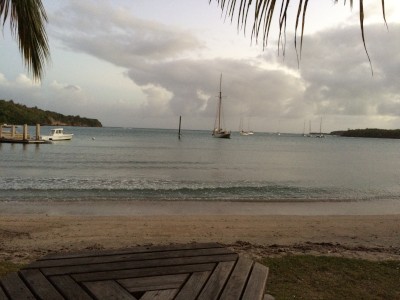
Sunday, March 15. Mt Hartman Bay, Grenada.
Been afloat about a week now. Working through my to do lists.
Everyday gets Someday cleaner, or shinier, or more stored away.
Been fighting ants, have a colony somewhere. got powder everywhere,
tracking them. they don’t bite, but they are fast. Connie’s bringing
her super bait traps. hope that works because nothing I do is.
Then there was,is the steering fluid leak. A copper tube for the hydraulic
steering rubbed itself so thin, it kinked and leaked. There’s an Ace hardware here,
near the Sherwin Williams paint store, and it is well stocked. But this is a french boat!
Did you know there is such a thing as metric copper tubing? Soooo, its repaired,
but it may need to be revisited. Someone defined cruising as fixing your boat in exotic locations.
It hasn’t been all work. I went to a concert at the medical college
at St George with a van load of other cruisers, to see the students and faculty
play jazz and classical on some unusual instruments. ( see video )
I also went to the national museum to hear poetry and jazz with cruisers
one night.
The cruisers organize and run a radio net every morning to share and stay informed and in touch. They start with any alerts or security issues. Then comes new arrivals or departures that can announce. Then goods and services, treasures of the bilge, then businesses announce lunch and dinner specials, and dive trips. Then shopping buses. its all very cute and very helpful. Some of the boats have been here or have been coming here for a long time and they know who or where you can get what you need.
There’s half price pizza night, trivia night, yoga, ti chi, local cooking classes, knot tying, knot untiying, ( massage class ), chess or dominos tournaments, you name it they have the time for it. Thats how I got involved with the concerts.
Well I’m pretty much provisioned, and ready to start playing. Connie comes down friday for three weeks. We will cruise up the Grenadines, and meet Steve and Cee in St Lucia for a week. Then they all fly home together.
Then I’ll continue north, alone. St Martaan in later april, the BVI’s, the USVI’s,
and Puerto Rico in May. No reservations for passengers, so get your passports out folks, and come down!
Well thats it from the good ship Someday. Happy cruising
Adventures in Paradise
Boury returned to experience St Thomas. Took him all around, he is becoming good at anchor and mooring ball duty. I took him to a Najee jazz concert for his B-Day at UVI, University of Virgin Islands. Who wouldn't want to do some post grad work there? The amphitheater there is a stunning venue. The night was beautiful.
He took me to every restaurant in St John in search of the perfect meal. Again, he is an incredible guest to have aboard. He is off to Europe for a month now.
St Thomas has, get ready, a Home Depot and a K-Mart!!!! I took the local 1 dollar jitney taxi, ($2 if you're white), to HD and got everything on my list for less than a hundred!! Try that at a marine store. At K-Mart I bought new linens on sale for the bunks! ( Do you think red sheets are a bit much)? ( But they were on sale!) Got towels and lots of other stuff.
David Geffin had his boat in STT. When Larry Ellison,( founder of Oracle), built it about 8 yrs. ago it was the largest private yacht in the world. Geffin owns it now and it is 9th largest at 460 feet. Wonder what number one is.
Diane arrived early feb, fresh back from 3 weeks in SE Asia. We journeyed to Fajardo, Puerto Rico, and did a road trip as the winds were up and boating not a real option. After driving some of the mountainous central region and sampling small, hidden, local cafes, we stayed in the old city of Ponce on the southern coast. They are slowly restoring the historic buildings to their splendor. The emphasis on art and pride of culture was evident everywhere we looked.
Ponce was/is a center for the arts and music, with music conservatories & museums everywhere. Next day, more mountain driving to Arecibo near the north coast, to see the largest radio telescope in the world.
Built in the 1960's in a natural depression, the reflector is over 1000 feet across and has been responsible for many discoveries in the cosmos since.
Beth and John Falakalowski arrived and we went to the islands off the east coast of PR.
Often called the Spanish Virgin islands, Culebra and Vieques were used as a US naval gunnery range as late as 2003. Certain areas are still restricted due to potential unexploded ordinance. You can't help but wonder when your anchor snags on something................
These are two little gems of laid back hospitality and sights. Culebra has Bahia Tortuga, the Bay of Turtles. Never seen more anywhere, they were surfacing for air all around the boat 3 and 4 at a time, and the oldest light house in the Carib.
The funky town of Dewey, with its salt river and draw bridge, had the most eclectic group of American ex-pats I've ever seen. The scene Fri. nite at the local bar, The Dingy Dock was a hoot.
The snorkeling on the west coast of Culebra was the best I have ever, ever, seen, including the world class FL Keys!!! HONEST. Miles of calm waters right inshore with more, continuous reefs then you can swim. We drifted along with the dingy so we could ride back to the boat. The yellow tails were the fattest I've ever seen. And tasty too!
Speaking of tasty, we caught Bonito while crossing between islands. They make some delicious sashimi. Diane is a great fisherperson, and cleans them as soon as they hit the boat!
Vieques has Mosquito Bay, with the highest concentration of Bio-Luminesce organisms in the world. We went kayaking there on a full moon nite, not the best, and were still impressed.
The town of Esperanza is full of great dining and a cute main street,( you are allowed to run an extension cord across the street to lite your little kiosk on the boardwalk). Neither island has a traffic light, Vieques has horses in the street. Both islands were charming with very friendly people who took pride in their community and hand painted signs and doorways and walls everywhere. Neither island had a marina of any sort, but they are within 15 miles of mainland PR and the same from STT, so logistics are not a problem. They feel a thousand relaxed miles from anywhere, very peaceful and serene.
After dropping B & J back in Fajardo, (They are always a scream aboard, we are still cleaning the walls), we went south a bit to Marina Del Rey, the largest marina in the Carib. 1000 slips! They do dry storage also and I may put the boat up there when I return. I'm on the waiting list. They also have one of the boats used in Pirates of the Carib. See pic gallery
Returning to STT, going to windward on an incredibly calm day, we saw Humpback whales. They are here this time of year for breeding off Dominican Republic. One breached six times! We followed them for 90 mins. Then, taking advantage of the rare calm, Diane got to snorkel in Cave Cove on an island on the north side of STT. There is a huge cave with no bottom you can see. There is nowhere to anchor so she had to go alone. She is very competent in the water and I knew she could do it. She returned home the 7th for more world travel. She was a wonderful first mate and can do everything on the boat.
Back in Charlotte Amalie harbor, waiting for Ava and Richard on the 10th. Then Connie comes down the 14th. Then Billy and Amy in Fajardo on the 24th. I guess I found a way to be popular; have a boat in the Carib!
Carol and Susan returned from yet another trip to India, where she performed a special ceremony for Nancy with the help of Denesh. The pictures are beautiful, and Whitney will forward them to you if you like. Whit, why don't you put them on FB for everyone to see. Thank you Carol and Susan. ( Carol, early April is available on Someday ) hint, hint
Happy B-day to Peter on Sat. and Sarah on Sunday, and all you folks I missed. Sorry but Nancy had a lock on that and kept me current.
Steve, who is graciously taking care of my pool, asked me the other day when I may be coming home. I asked him if the pool is warm enough to swim in yet.
He said, " No way".
I said, " Call me when it is".
From adventures in Paradise, Love to all, Capt. Joe
This is not the real world, this is St Thomas
Then it was off to USVI St Thomas. Clear out of BVIs at Soaper's Hole & into USVI at Cruz Bay St John.
Took a slip at Crown bay Marina in St Thomas & received 6 new AGM, ( Absorbed Glass Mat) batteries, a new hybred style. Now I have to upgrade my other alternator, already did the port side some time ago, to handle the capacity. Dropped off the laundry at the "Soap Opera Laundry". They called when it was done , I asked if anyone could run it over to me........She said," this is not the real world, this is St Thomas". I thanked her when I picked it up late
Joe Calta & Kat took came aboard for cocktails then took me to dinner. They showed me several great places on island & took me on a grand tour of the island. Thanks much for their time & attention.
Connie arrived the 11th & we left to explore St John. This island is almost all marine park, very protected, good, inexpensive mooring balls, $ 15! and beautiful protected beaches and shore sights. Cruz bay is home to the park system and a toni town full of upscale art & jewelry galleries & restaurants & shops. Her visit was too short and over too soon.
Then to a private mooring ball thanks to a local for 4 days and oil & trans fluid changes. I installed a five mile wifi antenna and installed an electrical outlet at the table to eliminate extension cords in the cabin.
Today, the 20th, I went offshore to Buck Island for snorkeling. Neat place 4 miles off St Thomas, then came and anchored in Secret Harbor for super bowl & dinner ashore. The wind calmed and it was beautiful.
Happy bday Cookie, 27 years, and many lessons learned. I believe when you stop learning you stop livin'. Carry on Cookie.
And thanks to the Burgesses for the picture in the Xmas card. Love you too.
Boury made plans to arrive in St T on the 25th. Beth and John in Purto Rico on Feb 22 Ava & Rich in St T on march 10.
Dave is in DR picking up his new sailing cat. Sail on David.
Remember: The difference between an adventure and an ordeal is your attitude.
Love to all Capt' Joe
